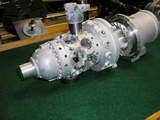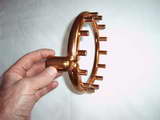Roach/Satra R1830 Radial
Click on photos to view larger versions
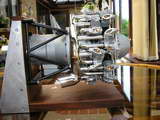 |
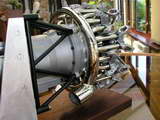 |
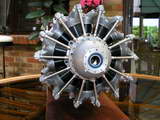 |
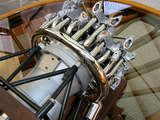 |
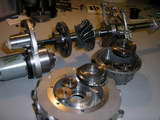 |
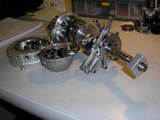 |
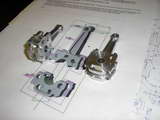 |
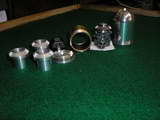 |
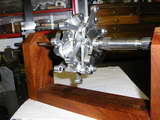 |
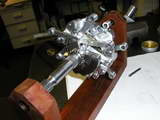 |
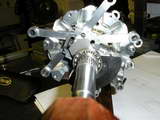 |
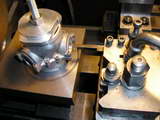 |
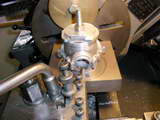 |
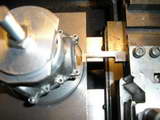 |
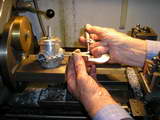 |
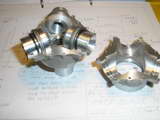 |
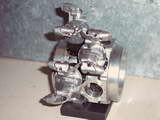 |
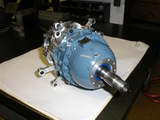 |
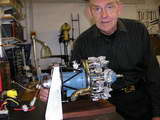 |
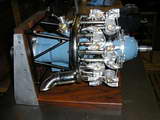 |
This is a one-sixth scale model of the Pratt & Whitney R-1830 "Twin Wasp" radial. According to the company website, production of the full-scale engine totaled 173,618 engines, making it the most widely produced piston engine we are ever, ever likely to see. The model pictured here combines the considerable skills of three gentlemen located in three countries just about as far from each other as it is possible to get and remain on the planet! The designer and draftsman is Mr Robert (Bob) Roach (Australia). The investment castings and the intricate dies that produce them are the work of Mr Bruce Satra (USA). Last but by no means least, the example in the photos is being masterfully built by Mr Ron Harris (UK).
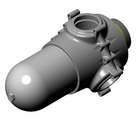 One of the airframes fitted with the Twin Wasp was the famous Douglas C47 "Gooney Bird" and Ron's model will feature a replica of the three blade, constant-speed prop hub (electric) used on that aircraft. The model hub will contain 63 gears. The sun gears are 9 tooth, 48 DP. The planets have 24 teeth, and the ring has 57. All divide by 3 so assembly is ok with five stages giving 21,200 to 1. The five-pole motor used comes from an O-class loco and does about 10,000 Revs, so the prop blades will turn at 0.5 RPM with plenty of torque. It is non reversible.
One of the airframes fitted with the Twin Wasp was the famous Douglas C47 "Gooney Bird" and Ron's model will feature a replica of the three blade, constant-speed prop hub (electric) used on that aircraft. The model hub will contain 63 gears. The sun gears are 9 tooth, 48 DP. The planets have 24 teeth, and the ring has 57. All divide by 3 so assembly is ok with five stages giving 21,200 to 1. The five-pole motor used comes from an O-class loco and does about 10,000 Revs, so the prop blades will turn at 0.5 RPM with plenty of torque. It is non reversible.
The picture of the hub seen above was modelled in Alibre Design, a 3D parametric tool described in the January 2008 Tech Tip. Bruce is producing the castings and Ron has the components ready to slip into them when they are ready. It's easy to look at pictures like that showing the gear train and admire the workmanship without thinking too deeply. For example, look at the very long internal tooth gear and ask yourself how just you'd go about machining that?
The model is progressing nicely and will feature an electric starter, tacho, and twin distributers for the dual ignition harnesses. Some photos of parts for it have appeared previously in the Gallery, such as this exhaust collector ring produced by electro-deposition which was subsequently nickel plated. Click on the thumbnails to visit the appropriate Gallery page. If you'd like to tackle one of these, Bob can supply a very complete and detailed set of plans, whlie Bruce has castings for the heads, crankcase nose, accessory case and prop hub.
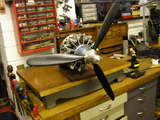 Here's progress as of October, 2008. The electrically controlled prop hub and unpainted blades have been fitted and the engine is really starting to take shape. The hub is another of Bruce Satra's investment castings and photos of it being machines (on a Myford, naturally) have been added to the montage at the head of this page. About the only "model" give-away is the carby visible at the top of the accessory case; then rest is pure miniature R1830.
Here's progress as of October, 2008. The electrically controlled prop hub and unpainted blades have been fitted and the engine is really starting to take shape. The hub is another of Bruce Satra's investment castings and photos of it being machines (on a Myford, naturally) have been added to the montage at the head of this page. About the only "model" give-away is the carby visible at the top of the accessory case; then rest is pure miniature R1830.
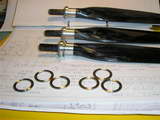 The diameter of the engine is eight inchs. As already mentioned, it has an electric variable pitch prop and is fitted with pressure oil feed, a self-starter, and spark ignition. The only castings used in construction are for the cylinder heads, crankcase nose, prop hub halves and rockers (steel); all else is cut from solid. The prop uses blades by Bolly, Australia. These are carbon fibre with an overall 20 inch diameter. Bolly is world renown for their model and ultra-light, sport aircraft props and other composite components. The prop motor turns 10,000 rpm and is geared to approx 22,000 to 1. The blade rotation is controlled by slip rings, just like the full size engine, providing forward, off, and reverse pitch. A governor could be fitted to make it automatic. The engine has 14 cylinders with 0.875 inch bore. The stroke is 24 mm (15/16 inch approx). The supercharger is useing a modified Cummins diesel blower wheel.
The diameter of the engine is eight inchs. As already mentioned, it has an electric variable pitch prop and is fitted with pressure oil feed, a self-starter, and spark ignition. The only castings used in construction are for the cylinder heads, crankcase nose, prop hub halves and rockers (steel); all else is cut from solid. The prop uses blades by Bolly, Australia. These are carbon fibre with an overall 20 inch diameter. Bolly is world renown for their model and ultra-light, sport aircraft props and other composite components. The prop motor turns 10,000 rpm and is geared to approx 22,000 to 1. The blade rotation is controlled by slip rings, just like the full size engine, providing forward, off, and reverse pitch. A governor could be fitted to make it automatic. The engine has 14 cylinders with 0.875 inch bore. The stroke is 24 mm (15/16 inch approx). The supercharger is useing a modified Cummins diesel blower wheel.
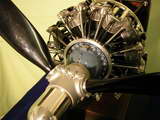 |
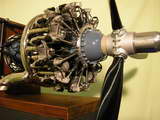 |
 |
 |
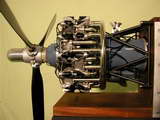 |
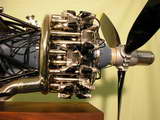 |
